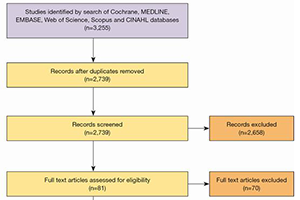Graft patency after open versus endoscopic saphenous vein harvest in coronary artery bypass grafting surgery: a systematic review and meta-analysis
Abstract
Background: Saphenous vein grafts (SVG) are a commonly used conduit for coronary artery bypass graft (CABG) surgery and can be harvested by either an open or endoscopic technique. Our goal was to evaluate long-term angiographic and clinical outcomes of open compared to endoscopic SVG harvest for CABG.
Methods: Electronic search was performed to identify all studies in the English literature that compared open and endoscopic SVG harvesting for CABG with at least one year of follow-up. The primary outcome was graft patency. Secondary outcomes included perioperative morbidity and mortality.
Results: Of 3,255 articles identified, a total of 11 studies were included for analysis. Of 18,131 patients, 10,873 (60%) patients underwent open SVG harvest and 7,258 (40%) patients underwent endoscopic SVG harvest. The mean age of patients was 65 years and 87% were male. The overall mean follow-up period was 2.6 years. During follow-up, patients who underwent open SVG harvest had superior graft patency per graft [open 82.3% vs. endoscopic 75.1%; OR: 0.61 (95% CI, 0.43–0.87); P=0.01], but higher rates of overall wound complications in the immediate post-operative period [open 3.3% vs. endoscopic 1.1%; OR: 0.02 (95% CI, 0.01–0.06); P<0.001]. Patients who underwent open SVG harvest had higher postoperative 30-day mortality [open 3.4% vs. endoscopic 2.1%; OR: 0.59 (95% CI, 0.37–0.94); P=0.03], but no significant difference in overall mortality [open 4.9% vs. endoscopic 4.9%; OR: 0.34 (95% CI, 0.50–1.27); P=0.34].
Conclusions: Patients who underwent an open SVG harvest technique had improved graft patency and comparable overall mortality to endoscopic SVG harvest at average follow-up time of 2.6 years. Patients with open SVG harvest had higher rates of early wound complications and postoperative 30-day mortality, however, there was no difference in overall mortality.
Cover






